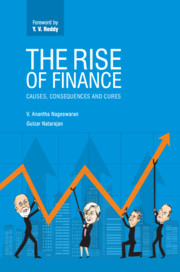8 - Conclusion
from Part C - The Cure
Published online by Cambridge University Press: 02 May 2019
Summary
It may not be inaccurate to describe the short financial history of recent decades largely in terms of three trends – progressive financial market liberalization, excessive financialization and the emergence of a new paradigm for central banking in which monetary policy had a role in destabilization of the economy and yet was invoked to help stabilize it too!
Our contention is that financial liberalization and financialization drove the monetary policy framework to accord a higher priority to preserve and to further financialization of the global economy. That is, the monetary policy framework that the United States and the rest of the developed world adopted is a consequence of financialization and, later, it worked to reinforce financialization.
While UMPs may have brought things to a head and exposed the depth of the challenge, these trends have been a result of long-term choices, especially those made by authorities and politicians in the United States. As we explained in Chapters 2 and 4, the economic policy preferences of the United States and the evolution of Fed's monetary policy paradigm have been the long-term drivers. Globalization and financial market integration ensured that the ripples were amplified and felt on a global scale.
The economic manifestations of these trends have been the resource misallocations (both human and physical capital) away from the real economy to the financial markets, concentration of market power and oligopolies across sectors, spillovers from monetary policy actions in United States and other developed economies, shorter cycles of asset bubbles and painful clean-ups, surges in cross-border capital flows followed by the inevitable sudden stops that engender fiscal imbalances, exchange rate volatility, egregious executive compensations and tax advantages that favour capital over labour, penalization of savers to benefit debtors and a widening of income inequality and concentration of wealth that matches the Gilded Age.
The inevitable political and social dynamics associated with them have been gradually building up. While widening inequality is intrinsically bad, the more corrosive impact is felt in the capture of political institutions that set the rules of the game. A global plutocracy is entrenched across countries. The populist political backlash in developed countries is only to be expected.
- Type
- Chapter
- Information
- The Rise of FinanceCauses, Consequences and Cures, pp. 264 - 276Publisher: Cambridge University PressPrint publication year: 2019



